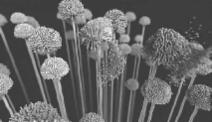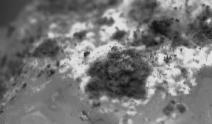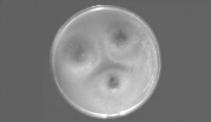MOLD
A mold is a fungus that grows in the form of multicellular filaments called hyphae. In contrast, fungi that can adopt a single celled growth habit are called yasts.
Molds are a large and taxonomically diverse number of fungal species where the growth of hyphae results in discoloration and a fuzzy appearance, especially on food.The network of these tubular branching hyphae, called a mycelium, is considered a single organism. The hyphae are generally transparent, so the mycelium appears like very fine, fluffy white threads over the surface. Cross-walls (septa) may delimit connected compartments along the hyphae, each containing one or multiple, genetically identical nuclei. The dusty texture of many molds is caused by profuse production of asexual spores (conidia) formed by differentiation at the ends of hyphae. The mode of formation and shape of these spores is traditionally used to classify molds. Many of these spores are colored, making the fungus much more obvious to the human eye at this stage in its life-cycle.
Molds are considered to be microbes and do not form a specific taxonomic or phylogenetic grouping, but can be found in the divisions Zygomycota and Ascomycota. In the past, most molds were classified within the Deuteromycota.
Molds cause biodegradation of natural materials, which can be unwanted when it becomes food spoilage or damage to property. They also play important roles in biotechnology and food science in the production of various foods, beverages, antibiotics, pharmaceuticals and enzymes. Some diseases of animals and humans can be caused by certain molds: disease may result from allergic sensitivity to mold spores, from growth of pathogenic molds within the body, or from the effects of ingested or inhaled toxic compounds (mycotoxins) produced by molds.

Pic 1. Black mold (Stachybotrys) from the walls of the bathroom under the microscope

Pic 2. Mold on the Russian space station "MIR" detected by US astronaut Colin Foale in 1997

Pic 3. Mold spores under the microscope
MOLD HEALTH ISSUES
Molds are ubiquitous in nature, and mold spores are a common component of household and workplace dust. However, when spores are present in large quantities, they are a health hazard to humans, potentially causing allergic reactions and respiratory problems.
Some molds also produce mycotoxins that can pose serious health risks to humans and animals. The term "toxic mold" refers to molds that produce mycotoxins, such as Stachybotrys chartarum, not to all molds. Exposure to high levels of mycotoxins can lead to neurological problems and in some cases death.[citation needed] Prolonged exposure, e.g., daily workplace exposure, can be particularly harmful.
Symptoms of mold exposure
Symptoms of mold exposure can include:
- Nasal and sinus congestion, runny nose
- Eye irritation, such as itchy, red, watery eyes
- Respiratory problems, such as wheezing and difficulty breathing, chest tightness
- Cough
- Throat irritation
- Sneezing / Sneezing fits
Infants may develop respiratory symptoms as a result of exposure to a specific type of fungal mold, called Penicillium. Signs that an infant may have mold-related respiratory problems include (but are not limited to) a persistent cough and/or wheeze. Increased exposure increases the probability of developing respiratory symptoms during their first year of life. Studies have shown that a correlation exists between the probability of developing asthma and increased exposure Penicillium. The levels are deemed no mold to low level, from low to intermediate, from intermediate to high.
Mold exposures have a variety of health effects depending on the person. Some people are more sensitive to mold than others. Exposure to mold can cause a number of health issues such as; throat irritation, nasal stuffiness, eye irritation, cough and wheezing, as well as skin irritation in some cases. Exposure to mold may also cause heightened sensitivity depending on the time and nature of exposure. People at higher risk for mold allergies are people with chronic lung illnesses, which will result in more severe reactions when exposed to mold.
There has been sufficient evidence that damp indoor environments are correlated with upper respiratory tract symptoms such as coughing, and wheezing in people with asthma.
MOLD-ASSOCIATED CONDITIONS
Health problems associated with high levels of airborne mold spores include allergic reactions, asthma episodes, irritations of the eye, nose and throat, sinus congestion, and other respiratory problems, although it should be noted that mold spores won't actually cause asthma, just irritate existing conditions. For example, residents of homes with mold are at an elevated risk for both respiratory infections and bronchitis.[8] When mold spores are inhaled by an immunocompromised individual, some mold spores may begin to grow on living tissue,[9] attaching to cells along the respiratory tract and causing further problems. Generally, when this occurs, the illness is an epiphenomenon and not the primary pathology. Also, mold may produce mycotoxins, either before or after exposure to humans, potentially causing toxicity.
Fungal infection
A serious health threat from mold exposure for immunocompromised individuals is systemic fungal infection (systemic mycosis). Immunocompromised individuals exposed to high levels of mold, or individuals with chronic exposure may become infected. Sinuses and digestive tract infections are most common; lung and skin infections are also possible. Mycotoxins may or may not be produced by the invading mold.
Dermatophytes are the parasitic fungi that cause skin infections such as athlete's foot and tinea cruris. Most dermataphyte fungi take the form of a mold, as opposed to a yeast, with appearance (when cultured) that is similar to other molds.
Opportunistic infection by molds such as Penicillium marneffei and Aspergillus fumigatus is a common cause of illness and death among immunocompromised people, including people with AIDS or asthma.
Mold-induced hypersensitivity
The most common form of hypersensitivity is caused by the direct exposure to inhaled mold spores that can be dead or alive or hyphal fragments which can lead to allergic asthma or allergic rhinitis. The most common effects are rhinorrhea (runny nose), watery eyes, coughing and asthma attacks. Another form of hypersensitivity is hypersensitivity pneumonitis. Exposure can occur at home, at work or in other settings. It is predicted that about 5% of people have some airway symptoms due to allergic reactions to molds in their lifetimes.
Hypersensitivity may also be a reaction toward an established fungal infection in allergic bronchopulmonary aspergillosis.
Mycotoxin toxicity
Molds excrete toxic compounds called mycotoxins, secondary metabolites produced by fungi under certain environmental conditions. These environmental conditions affect the production of mycotoxins at the transcription level. Temperature, water activity and pH, strongly influence mycotoxin biosynthesis by increasing the level of transcription within the fungal spore. It has also been found that low levels of fungicides can boost mycotoxin synthesis. Certain mycotoxins can be harmful or lethal to humans and animals when exposure is high enough.
Extreme exposure to very high levels of mycotoxins can lead to neurological problems and in some cases death; fortunately, such exposures rarely to never occur in normal exposure scenarios, even in residences with serious mold problems. Prolonged exposure, such as daily workplace exposure, can be particularly harmful.
The health hazards produced by mold have been associated with sick building syndrome, but no validated studies have been able to demonstrate that normal indoor exposures to these common organisms pose a significant threat.
It is thought that all molds may produce mycotoxins and thus all molds may be potentially toxic if large enough quantities are ingested, or the human becomes exposed to extreme quantities of mold. Mycotoxins are not produced all the time, but only under specific growing conditions. Mycotoxins are harmful or lethal to humans and animals only when exposure is high enough.
Mycotoxins can be found on the mold spore and mold fragments, and therefore they can also be found on the substrate upon which the mold grows. Routes of entry for these insults can include ingestion, dermal exposure and inhalation.
Some mycotoxins cause immune system responses that vary considerably, depending on the individual. The duration of exposure, the frequency of exposure and the concentration of the insult (exposure) are elements in triggering immune system response.
Aflatoxin is an example of a mycotoxin. It is a cancer-causing poison produced by certain fungi in or on foods and feeds, especially in field corn and peanuts.
Originally, toxic effects from mold were thought to be the result of exposure to the mycotoxins of some mold species, such as Stachybotrys chartarum. However, studies are suggesting that the so-called toxic effects are actually the result of chronic activation of the immune system, leading to chronic inflammation. Studies indicate that up to 25% of the population have the genetic capability of experiencing chronic inflammation to mold exposure, but it is unknown how many actually experience such symptoms due to frequent misdiagnosis. A 1993–94 case study based on cases of pulmonary hemorrhage in infants in Cleveland, Ohio originally concluded there was causal relationship between the exposure and the disease. The investigators revisited the cases and established that there was no link to the exposure to S. chartrum and the infants in their homes.
From Wikipedia, the free encyclopedia